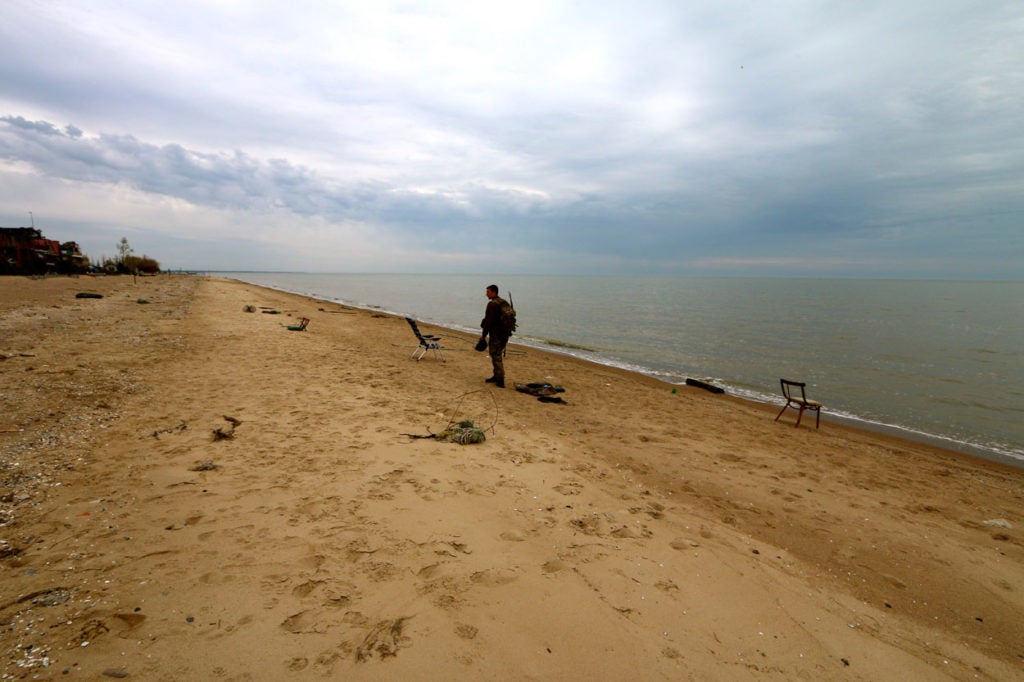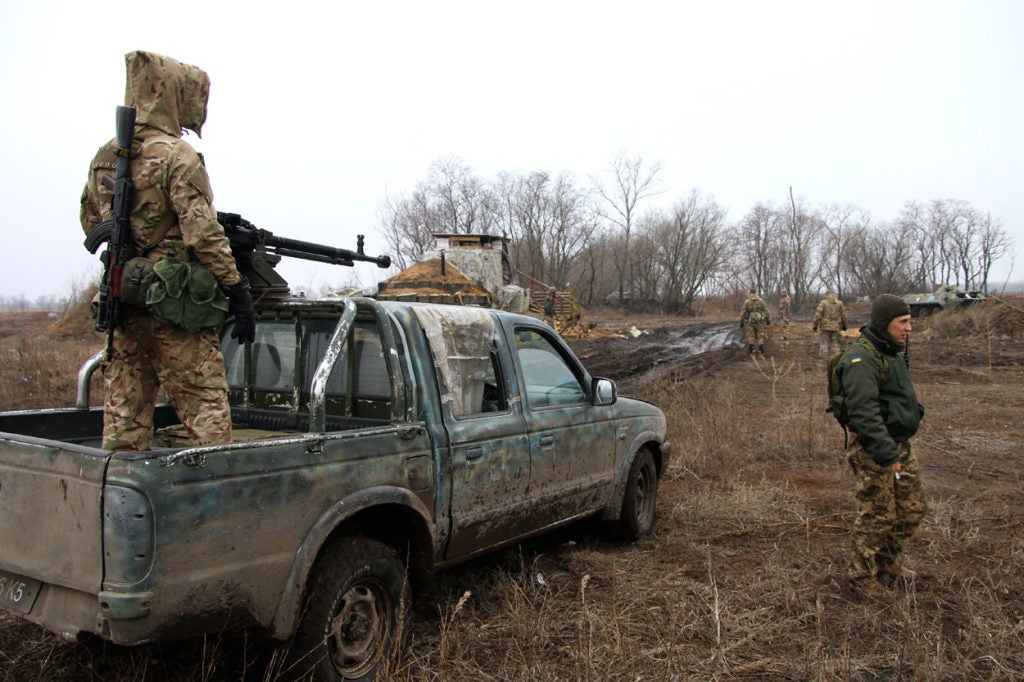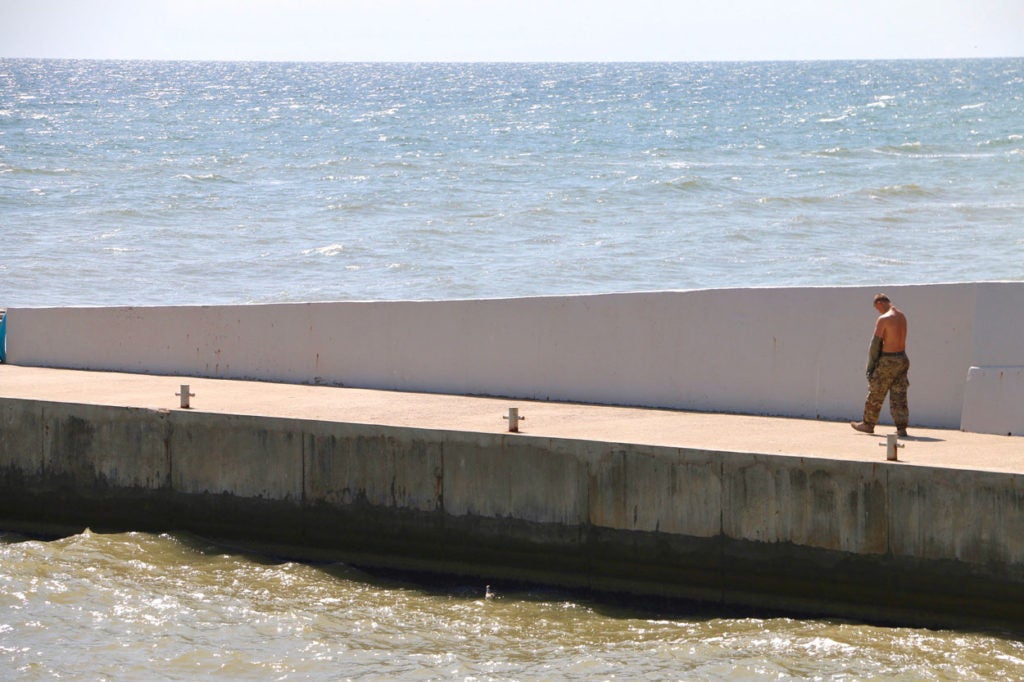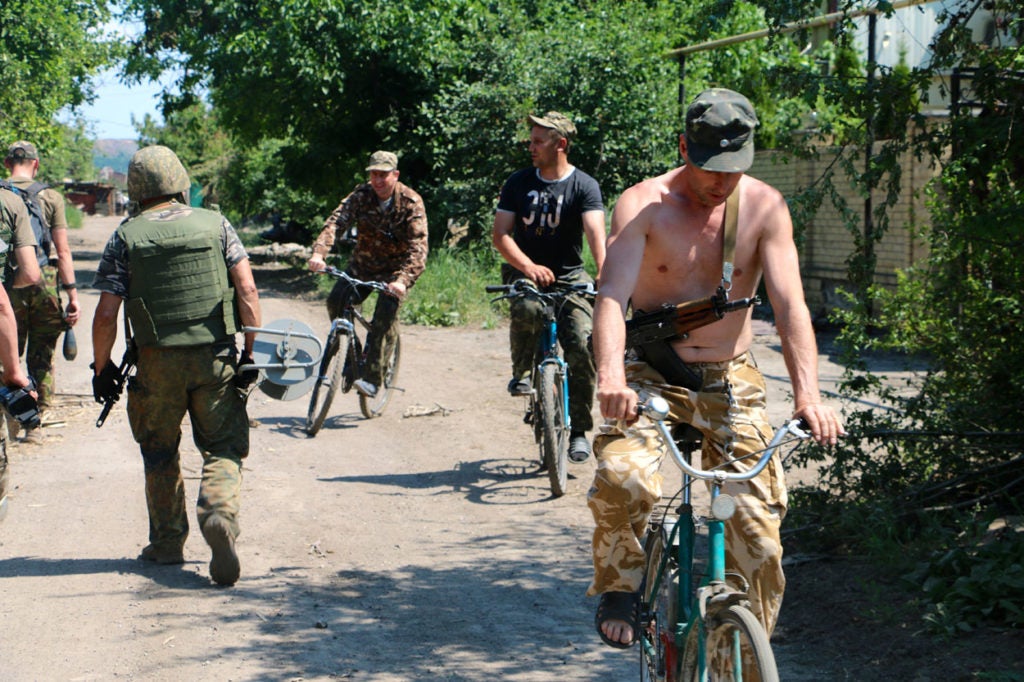Ukraine Rebuilds Its Military Muscle to Repel a Russian Invasion
Nolan Peterson /
KYIV, Ukraine—For the past four and a half years, Ukraine’s military has prioritized rebuilding land warfare units to meet the immediate needs of the ongoing war in the country’s embattled, eastern Donbas region.
This year, however, Ukraine has stepped up efforts to rebuild its air force and navy, too. This emphasis reflects a national security doctrine that singles out a Russian invasion as the top, long-term national security threat, while also keeping an eye toward improving interoperability with NATO forces.

A Ukrainian soldier walks along the beach in Shyrokyne, the southern terminus of the war’s front lines on the Sea of Azov. (Photos: Nolan Peterson/The Daily Signal)
This October, Ukraine will hold its largest air combat exercise in the post-Soviet era, including the participation of U.S. Air Force F-15C fighters. Meanwhile, Kyiv is steadily deploying more troops to its southern Sea of Azov coastline and building up a shallow-water navy to defend against a rising tide of Russian aggression against Ukraine’s merchant fleet.
“Steps to rebuild Ukraine’s armed forces are done with a view to a full-scale war with Russia, not only the need to wage the local conflict in the Donbas,” Mykola Bielieskov, a defense analyst at the Institute of World Policy, a Ukrainian think tank, told The Daily Signal.
“We are realistic that the Russian threat is here and it’s not going to disappear in the next 10 to 15 years,” Bielieskov said. “Moreover, the threat or use of military power is now the only credible instrument Russia can use with regards to Ukraine to accomplish its aims.”
After more than four years of constant combat, artillery still thunders along a 250-mile-long front line in the Donbas where Ukraine’s military continues to fight a static, trench war against a combined force of pro-Russian separatists, foreign mercenaries, and Russian regulars.
When Russia invaded in April 2014, Ukraine’s regular army had been depleted by decades of corruption and immediately was able to field only 6,000 combat-ready soldiers, Ukrainian officials say.
Yet, in the past four and a half years—and while fighting a war to keep the Russian invasion at bay—Ukraine has rebuilt its military into the second largest in Europe in terms of manpower.
Today, Ukraine’s combined military ranks comprise about 250,000 active-duty troops and roughly 80,000 reservists. That’s about double the number of active-duty troops from 2014. And of that number, the percentage of troops who are battle-hardened and ready for combat is much higher, Ukrainian military officials and experts say.
On the Continent, only Russia’s military is bigger than Ukraine’s in terms of standing manpower.
Ukraine’s military rebuild is no longer a crash-course effort to keep the country from collapsing under the immediate pressure of Russia’s war in the east. Rather, the ongoing rebuild of Ukraine’s combined armed forces—including land, sea, air, and cyber forces—underscores Kyiv’s assessment that Russia will remain an existential threat for years to come.
“Ukraine is preparing itself for a full-scale war with Russia,” Bielieskov said. “And there is no other choice, because Russia is creating new combat units and moving existing land armies near its border with Ukraine.”
Ukraine has also declared its intentions to join NATO ultimately, touting the Western alliance’s collective security pledge as a deterrent against Russian aggression. To that end, adopting NATO standards by the year 2020 is a top priority for Ukrainian President Petro Poroshenko.
Air Power
In October, Ukraine will hold its first-ever Clear Sky exercise—the country’s largest air combat exercise in the post-Soviet era.
Approximately 950 personnel from nine nations will participate, including the U.S. Air Force, which will send F-15C fighters and other aircraft. Also, U.S. joint terminal attack controllers, or JTACs, will help train their Ukrainian counterparts in directing airstrikes from the ground.
“The Clear Sky-2018 exercises will contribute to security in Eastern Europe and will make it possible to enhance the training levels of Ukrainian Air Force crews,” the Ukrainian Ministry of Defense said in a formal statement, adding that the exercise will help “protect the sovereignty of our airspace.”
Training will focus on a variety of air combat skill sets and, altogether, the exercise will be a milestone first step toward modernizing the combat capabilities of Ukraine’s air force and a bellwether for more joint air combat training in the future between Ukrainian and NATO forces.
It’s also another instance of how Ukraine is diversifying its military buildup beyond just its ground forces to defend against the Russian threat.

The war in Ukraine is not a hybrid war. Rather, the conflict is a conventional war with a hybrid edge, which continues to destabilize the whole country.
“What we are currently witnessing is, in my opinion, a sign of a logical transition from the post-Soviet army to a modern, smart, highly motivated, and well-trained army of a sovereign state,” Maksym Kyiak, a Ukrainian political analyst who is deputy head of the Central European Institute, told The Daily Signal.
The Donbas is now among the most heavily defended airspaces on earth. The area brims with modern Russian surface-to-air missile systems, posing a grave threat to Ukraine’s Cold War-era warplanes, as well as commercial air traffic.
According to news reports, combined Russian-separatist forces shot down seven Ukrainian fighter and attack aircraft, three transport aircraft, and at least nine helicopters over eastern Ukraine prior to the first cease-fire, which took hold on Sept. 5, 2014.
And on July 17, 2014, a Russian surface-to-air missile downed Malaysia Airlines Flight 17 over Russian-controlled territory in eastern Ukraine—killing all 298 people aboard.
Due to a halt in combat air operations, Ukraine has not lost any aircraft to enemy fire since the September 2014 cease-fire. Yet, according to the Ukrainian military, Russian air defense forces are still moving into eastern Ukraine.
Stress Test
The conflict in eastern Ukraine began in April 2014 as a Russian hybrid warfare operation. It comprised Russian special operations forces and intelligence operatives who operated alongside Ukrainian separatists and foreign mercenaries.
In the early months of the war, Ukraine’s regular army was on its heels as Russia’s hybrid forces leapfrogged across the Donbas, taking town after town.
“Four and a half years ago, Ukraine’s armed forces existed largely on paper and their readiness was meager—only 6,000 of 125,000 were ready and able to fight on first order,” Bielieskov said.
Yet, by July 2014—three months into the conflict—Ukraine’s ad hoc armed forces had retaken 23 of the 36 districts previously under combined Russian-separatist control.
It was a grassroots war effort. Everyday Ukrainians had banded together, filling the ranks of volunteer combat outfits that fought alongside regular army units while legions of civilian volunteers ferried supplies to support the ragtag coalition. Many of the Ukrainian volunteer soldiers had no military training at all. What little on-the-job training they received was commonly referred to as “natural selection.”
In the summer of 2014, with its hybrid war in shambles, Russia outright invaded Ukraine with thousands of its own troops. By then the war was no longer a hybrid conflict. It had metastasized into a mechanized, mobile war, comprising tanks, artillery, and rocket barrages.
The operative, Minsk II cease-fire—the war’s second, signed in February 2015—has effectively frozen the conflict along current geographical boundaries. In theory, by proscribing the use of certain heavy weapons, the cease-fire moderates the intensity of combat.
Yet, in reality, the war never ended. It’s become a long-range battle, marked by daily shelling and small arms gun battles. At some places, no man’s land can be several kilometers wide. At others, the Ukrainians and their enemies are close enough to shout insults at each other.
‘We Must Be Ready’
Today, the war in Ukraine is not a hybrid war. Rather, the conflict is a conventional war with a hybrid edge, which continues to destabilize the whole country.
“We must be ready now, and tomorrow, and in a week, and in one year, and in three years, until this threat, a threat of a military aggression against Ukraine, ceases to exist,” Gen. Viktor Muzhenko, chief of General Staff of the Armed Forces of Ukraine, said in February.
Inside the two breakaway territories in the Donbas, about 3,000 Russian soldiers are embedded within a larger force of about 34,000 pro-Russian separatists and foreign mercenaries. Compounding the threat, Russia has positioned about 77,000 troops on Ukraine’s borders capable of launching a rapid, conventional land invasion.
Additionally, about 40,000 Russian troops are deployed to Crimea, Ukrainian military officials say, and the Russian navy has about 40 ships assigned to the Sea of Azov.
Ukraine, for its part, has about 60,000 troops deployed to the war zone, with tens of thousands more ready to rapidly defend its Sea of Azov and Black Sea coastlines.
Logistical challenges still dog Ukraine’s war effort and many Ukrainian troops wield Soviet-era, hand-me-down weapons and hardware. Civilian volunteers continue to make up for government shortfalls by delivering supplies to the front lines, including uniforms, food, water, and combat first-aid kits.
Still, Ukraine’s meteoric military renaissance has upheaved Eastern Europe’s pre-2014 balance of power. Today, Europe’s two largest standing land armies remain locked in a de facto state of war and countries across Eastern Europe are rapidly militarizing to defend against Russia.
Thus, the spectre of a much larger, far deadlier conflict waxes and wanes with the pace of combat in the Donbas.
New Domains
On April 27, Russia began a blockade of Ukrainian merchant vessels in the Sea of Azov, spurring Kyiv to deploy more troops to the Sea of Azov and Black Sea regions.
A new Marine brigade is slated to stand up in the region by the end of October. And Thursday, Ukraine’s Border Guard Service announced deployment of 270 navy special forces soldiers to the southern coastal regions.
“In response to Russia’s aggressive actions in the Azov Sea, based on the decision of the General Staff of the Armed Forces of Ukraine, we will reinforce the deployed forces, including ground forces, in the direction of the Azov Sea,” Lt. Gen. Serhii Popko, commander of Ukrainian Ground Forces, wrote Wednesday on Facebook.
“To this end,” Popko wrote, “we are taking measures to ensure the full control of the situation in the region, to support ship deployment, and to ensure reliable defense of the coast.”
Russia’s 2014 takeover of Ukraine’s Crimean Peninsula left 80 percent of Ukraine’s navy in the Kremlin’s hands. Rather than replace the blue-water warships lost in Crimea, however, Ukrainian military leaders have prioritized creation of a “mosquito fleet” of shallow-water craft armed with advanced anti-ship weapons.
“Ukraine today has to and is trying to rebuild its sea strength,” Andrii Telizhenko, a Kyiv-based political and security consultant, told The Daily Signal. He added: “The military only began to take real actions in the navy after more and more persistent Russian pressure in Azov Sea increased as of last year.”
Still, some experts say Ukraine needs to do more to harden its Sea of Azov defenses—and that its Western partners, including the U.S., should do more to help.
“Given the firepower that Russia has already deployed to the Azov Sea and may promptly deploy from its Black Sea fleet stationed in annexed Crimea … Ukraine can do little without the support of its Western allies,” Alexander Khara, deputy chairman of the Black Sea Institute of Strategic Studies, told The Daily Signal.
“The Ukrainian Armed Forces face threats from various directions,” Khara added.
‘March of the New Army’
On Aug. 24, U.S. national security adviser John Bolton stood on the sidelines of a military parade in Kyiv celebrating Ukraine’s 27th Independence Day.
About 4,500 Ukrainian troops from various service branches marched down the capital city’s main thoroughfare of Khreshchatyk alongside 300 foreign soldiers from 18 countries, including the United States. Among the military hardware on display were Ukrainian-made tanks, mobile artillery pieces, anti-aircraft weapons—as well as some coveted U.S. Javelin anti-tank missiles.

A Ukrainian soldier walks along a seawall at a base on the Sea of Azov coast—the new hot spot in the war.
It was Ukraine’s fifth consecutive Independence Day at war, and organizers named the parade “March of the New Army.” It was an impressive spectacle, both in its scale and in the sharp, modern appearance of the troops and the military hardware they wielded.
Ostensibly, the parade celebrated Ukraine’s independence from Moscow after the Soviet Union’s breakup. Yet, the pageantry and military displays were also a symbolic testament to how far Ukraine’s military has come from the rudderless, dilapidated force it was in 2014 when Russia invaded.
“The [past] four and a half years were a tough time for us. Thousands of Ukrainians, military and civilian, have died from the hands of the enemy,” Poroshenko said at the parade while Bolton looked on.
“Ukraine has been tested by war and economic crisis,” Poroshenko continued. ”Thank God that we have survived and built strong muscles.”



